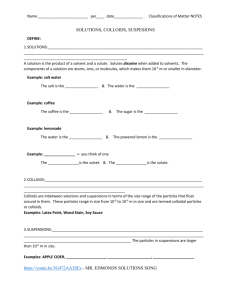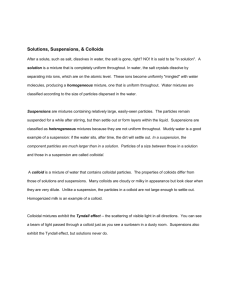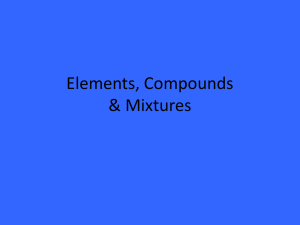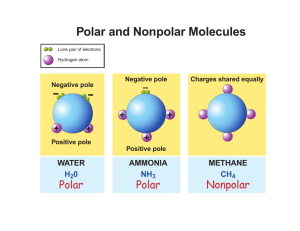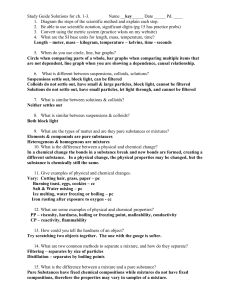Classification of Matter
advertisement
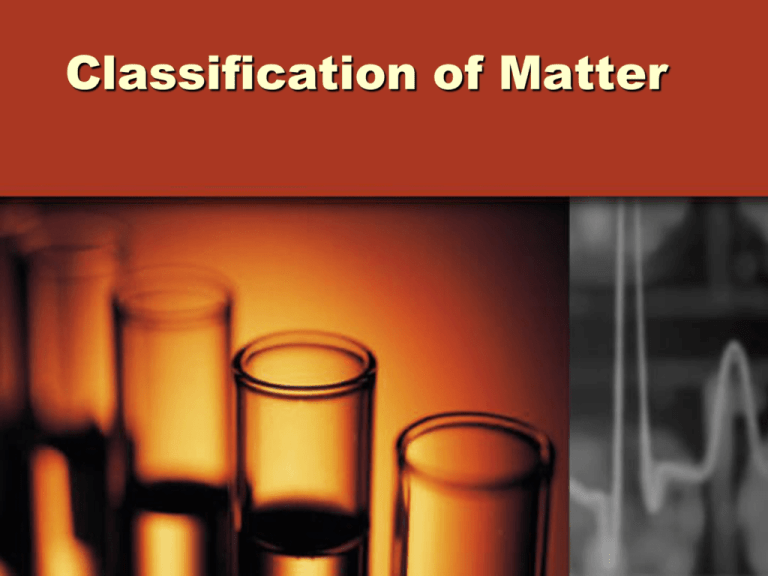
Classification of Matter Have you thought about all of the objects that matter can be broken down into? Matter Mixtures Heterogeneous Mixtures Physical Changes Homogeneous Mixtures Pure Substances Elements Compounds Pure Substances: MATTER THAT IS THE SAME THROUGHOUT: 1. Same Composition 2. Same Physical and Chemical Properties Pure Substances Elements Compounds Chemical Changes Elements are: - The simplest form of matter. - Can not be broken down into simpler substances. Examples: Gold, Oxygen, and Platinum Everything in the universe is made up of elements. Today over 114 elements have been discovered. They combine chemically to form compounds Compounds are: • Combinations of two or more different elements combined chemically • Most of the matter in the universe are compounds • Examples: Water, Salt, and Aspirin Mixtures: COMBINATION OF TWO OR MORE SUBSTANCES: There are 3 types of Mixtures: 1. Solutions 2. Colloids 3. Suspensions Mixtures Heterogeneous Mixtures Homogeneous Mixtures Colloids and Suspensions Solutions Homogeneous VS Heterogeneous • Homogeneous • Heterogeneous – “Homo-”: the same – “Hetero”-: different Mixtures – Composition is the same throughout Mixtures – Composition is inconsistent Examples: lemonade, gasoline, steel, salt water Examples: orange juice, pizza, dirt, blood, milk Colloids ● Colloids have particles that are small to medium in size. ● The particles in a colloid do not settle out. ● Colloids have a positive Tyndell Effect What is a Tyndell Effect? • A Tyndell Effect is when dispersed colloid particles are large enough to scatter light. ◊If you can see a beam of light then there is a Tyndell Effect (positive) ◊If you can not see a beam of light then there isn’t a Tyndell Effect (negative) Colloids ● Colloids appear cloudy. ● The particles in a colloid are not filtered out. ● Examples of colloids are: milk, mayonnaise, and fog Suspensions • Suspensions have medium to large sized particles. Sometimes you can see them with your eyes. • Suspensions settle out when they are left alone. • Suspensions have a positive Tyndell Effect. • Suspensions may appear cloudy or chunky. Suspensions • Suspensions have particles that are large enough to be filtered out (they can be caught by a filter). • Examples of suspensions are: - Italian salad dressing -Snow globes -Smoke -Dust in the air -Orange Juice Solutions ● ● ● ● ● Solutions are made when a solute (like sugar) is dissolved into a solvent (like water). Solutions have tiny particles that you can’t even see with a microscope. Solutions do not settle out when they are left alone. Solutions do not have a positive Tyndell Effect. Solutions are clear (not necessarily colorless). Solutions Particles are not filtered out. ● Examples of solutions are: - Soft drinks - Tea - Windex ● Let’s Break it Down… Mixture Type Colloid Solution Suspension Homo or Hetero Hetero Homo Hetero Size Small to medium sized particles Microscopic sized particles Medium to Large sized particles Tyndell Effect? Filter? Yes No Yes No No Yes Examples Milk Kool-aid Orange Juice
